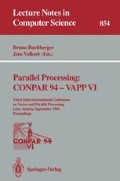Abstract
Based on a stepwise software development methodology in this paper a possibility is presented to formally describe the algorithmic details and hardware-characteristics influencing efficient problem solutions for massively parallel systems. Variability at the specification level is introduced by the possibility to express properties and modification rules of the mathematical objects and expressions the algorithm is based on. The underlying details of the (massively parallel) architecture are described in terms of an abstract data type (ADT) along with transformation rules connecting architecture independent descriptions (based on recurrence equations) and target system characteristics. By this means it is also possible to specify special language and library support along with their performance characteristics, thus forming a basis for a performance model of the architecture. A simple example is presented illustrating our approach taking the MasPar SIMD system [Bla90] as the target architecture.
Preview
Unable to display preview. Download preview PDF.
References
Michael Barnett. The formal derivation of distributed programs from systolic arrays. In Proceedings Supercomputing, pages 363–366, 1990.
T. Blank. The MasPar MP-1 Architecture. In Proceedings IEEE Compcon, 1990.
M. Chenand, Y Choo, and J. Li. Crystal: Theory and Pragmatics of Generating efficient parallel Code, chapter 7, pages 255–308. Addison Wesley, 1991.
M.I. Cole. Algorithmic Skeletons: Structured Management of Parallel Computation. Pitman, 1989.
J. Darlington, A.J. Field, P.G. Harrison, P.H.J. Kelly, Q. Wu, and R.L. While. Parallel programming using skeleton functions. In PARLE93, Parallel Architectures and Languages Europe, June 1993.
Max Geerling. Two examples of parallel program derivation: Parallel prefix and matrix multiplication. Technical report, University of Nijmegen, The Netherlands, 1992.
P. Hudak, Jones S. Peyton, and P. Wadler. Report on the programmming language Haskell: A non strict purely functional language (version 1.2). ACM SIGPLAN notices, 27(5), 1992.
Jingke Li and Marina Chen. The data alignment phase in compiling programs for distributed-memory machines. Journal of Parallel and Distributed Computing, 13:213–221, 1991.
Björn Lisper. Synthesis of time-optimal systolic arrays with cells with inner structure. Journal of Parallel and Distributed Computing, 10:182–187, 1990.
C. Mauras, P. Gachet, P. Quinton, and Y. Saouter. Alpha du centaur: An environment for the design of regular algorithms. In International Conference on Supercomputing, Crete, 1989.
H. Partsch. Specification and Transformation of Programs — a Formal Approach. Springer, 1990.
Boleslaw K. Szymanski. EPL: Parallel Programming with Recurrent Equations, chapter 3, pages 51–104. Addison Wesley, 1991.
Ping-Sheng Tseng. A systolic array parallelizing compiler. Journal of Parallel and Distributed Computing, 9:116–127, 1990.
E. Violard and G.-R. Perrin. PEI: A language and its refinement calculus for parallel programming. Parallel Computing, 18:1167–1184, 1992.
Stephen Wolfram. Mathematica, A System for Doing Mathematics by Computer. Addison Wesley Publishing Company, 1991.
A. Yang. Design and implementation of meta-Crystal: a metalanguage for parallel program optimization. Technical report, Department of Computer Science, Yale University, 1989.
Norihiko Yoshida. A transformational approach to the derivation of hardware algorithms form recurrence equations. In Proceedings Supercomputing, pages 433–440, 1988.
Author information
Authors and Affiliations
Editor information
Rights and permissions
Copyright information
© 1994 Springer-Verlag Berlin Heidelberg
About this paper
Cite this paper
Kindermann, S. (1994). Flexible program and architecture specification for massively parallel systems. In: Buchberger, B., Volkert, J. (eds) Parallel Processing: CONPAR 94 — VAPP VI. VAPP CONPAR 1994 1994. Lecture Notes in Computer Science, vol 854. Springer, Berlin, Heidelberg. https://doi.org/10.1007/3-540-58430-7_15
Download citation
DOI: https://doi.org/10.1007/3-540-58430-7_15
Published:
Publisher Name: Springer, Berlin, Heidelberg
Print ISBN: 978-3-540-58430-8
Online ISBN: 978-3-540-48789-0
eBook Packages: Springer Book Archive

